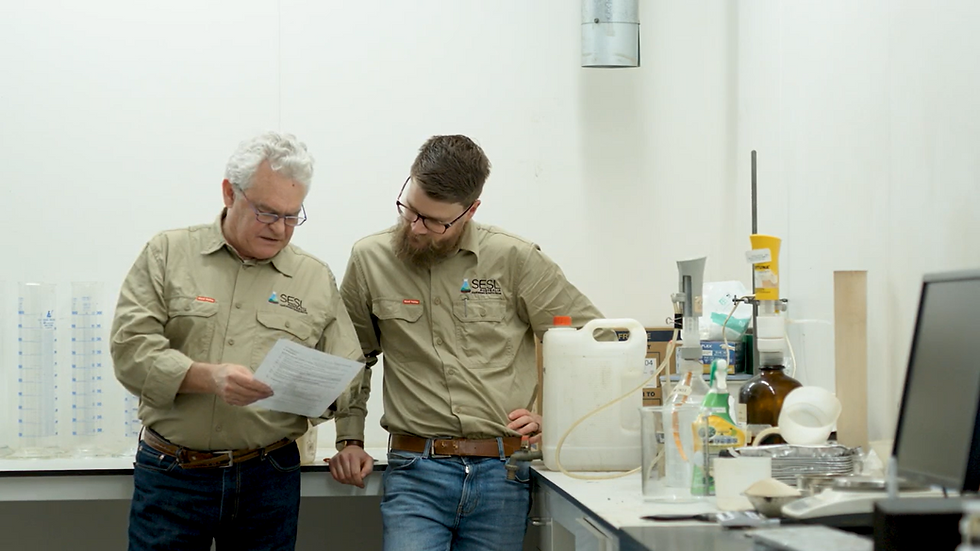Digging Deeper: An Interview with SESL Australia’s Soil Experts
- Michael Veron
- Oct 14
- 4 min read
At SESL Australia, we’re passionate about soil, science, and sustainable solutions. To give our readers a closer look at what drives our work, I sat down with our founder and Head of Science, Simon Leake, and our Soil Science Manager, Owen Guy, to talk about their journey, the challenges of modern soil management, and the future of the industry.

Q: Simon, let’s start with you. SESL Australia has been around since 1984. What inspired you to start the company?
Simon: I started SESL Australia because I saw a gap between pure soil science research and how it was being applied in real-world projects. Back then, there wasn’t much of a bridge between academia and industry. I wanted to create a place where rigorous science could guide practical solutions, whether that’s helping landscapers, councils, farmers, or developers work with soil in a way that actually lasts.
Q: Owen, you manage the Soil Science team today. What drew you to this field, and eventually to SESL Australia?
Owen: I studied agriculture all through high school and university, which gave me an appreciation for how soil plays a critical role in everything around us. Soil is the foundation of our food sources and provides us with a great deal of amenity that is often overlooked. When I saw the job opening for a Graduate Soil Scientist at SESL Australia some time ago, it was a no-brainer. I had to see where it could lead me. At SESL Australia, we get to work on such a variety of projects, from urban developments to agronomy to engineered green wall installations, and that’s what keeps me interested. It would be reasonable to think that the everyday job of a Soil Scientist is just piles of dirt, but I still never know what is on the horizon.
Q: SESL Australia has built a reputation for independent, evidence-based advice. Why is that independence so important?
Simon: Independence is everything. When clients come to us, they know they’re getting advice that isn’t swayed by suppliers or commercial interests. Our role is to interpret the science and tell the truth about what the soil is saying, even if that sometimes means delivering hard news.
Owen: Exactly. Soil data doesn’t lie, but it does need interpreting and a deep understanding. Our independence gives clients the confidence that the recommendations we provide are based on solid data, experience and knowledge, not sales.
Q: What do you see as the biggest challenges facing soil management in Australia right now?
Owen: Rapid urbanisation is a big one. In most cases nothing beats suitable site topsoil when it comes to landscaping or revegetation, which is often overlooked when new projects are being built at a blistering pace. Proper consideration and respect for soil management early on in a project can lead to huge savings and more importantly, sustainable re-use of site soils in successful landscapes. We regularly work with design teams to ensure that soil is front of mind at the early stages, and this respect is carried through to completion.
Simon: And climate change, of course. More extreme weather events are stressing soils, especially in agriculture. We need to adapt management practices to maintain resilience, whether that’s improving organic matter, rethinking water use, or finding new ways to measure soil health.
Q: SESL Australia works across so many sectors, agriculture, urban development, waste recycling. How do you balance that diversity?
Simon: To me, it’s all interconnected. Whether you’re growing wheat or building a park, it comes down to understanding the soil and how it interacts with its environment.
Owen: And our team thrives on variety. One day we’re advising on a sports field, the next it’s a vineyard or a heavily contaminated site. The diversity keeps us sharp, it pushes us to apply the fundamentals of soil science in new ways.
Q: Looking ahead, what excites you most about the future of soil science?
Simon: The potential for soils to be part of the climate solution. There’s a lot of talk about carbon sequestration and regenerative agriculture, and while we need to be cautious about overstating the potential, it’s an exciting area of research and practice.
Owen: I’d add technology. Tools like remote sensing, GIS, and digital soil mapping are giving us insights we couldn’t imagine a few decades ago. But they’ll never replace the need for good old-fashioned soil sampling and analysis, you still have to dig holes!
Q: Finally, what’s the one thing you wish more people understood about soil?
Simon: That it’s alive. Soil isn’t just dirt, it’s a living system, and when we respect that, everything else follows.
Owen: Soil is a finite resource, regardless of if it is an in-situ resource or a manufactured soil from a landscaping yard. As we continue to develop areas, this resource is being used up or reallocated, we must make the most of what is suitable or able to be amended (not all topsoil is good) and ensure that soil is used as sustainably as possible in all aspects.
At SESL Australia, we will keep championing that message: healthy soils are the foundation of healthy communities, landscapes, and industries. Thanks to Simon and Owen for sharing their insight, and for reminding us that every great project really does start from the ground up.



Comments